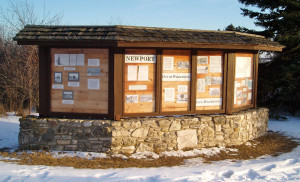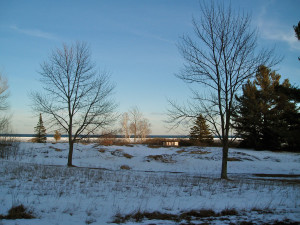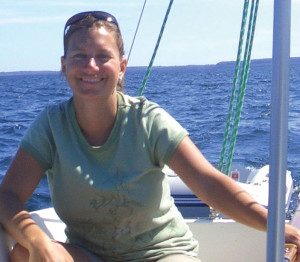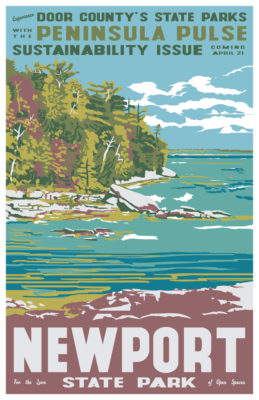With a Little Help from My Friends
- Share
- Tweet
- Pin
- Share
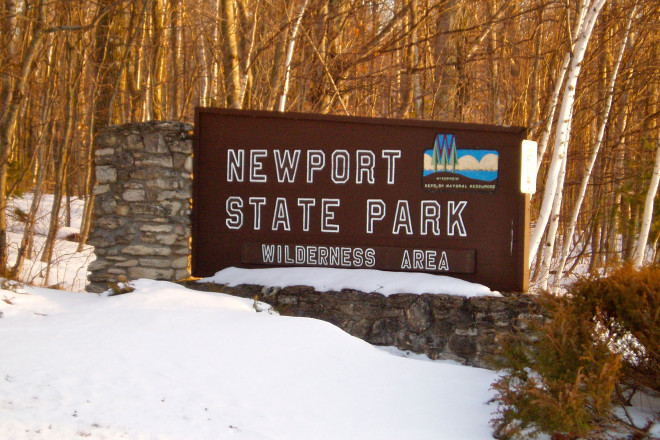
Visitors to Newport State Park can learn about the area’s cultural history by visiting a sizable kiosk just a short walk from parking lot three. This impressive structure was partially funded by the Newport Wilderness Society, along with the Door County Historical Society. “We are standing right about here,” remarks Jack Travis, current President of the Newport Wilderness Society, as he points to a plat map that is part of the display. His finger rests on a shoreline lot, one of hundreds plotted on this intricate map that represents the dramatically different future once envisioned for the property.
Those who treasure the tranquility of this unique setting can reflect on their good fortune with appreciation for Ferdinand Hotz. The Hotz legacy included not only 1,472 acres of pristine wilderness, but a philosophy of nature “to leave all living things in their place undisturbed.” Ferdinand Hotz’s descendants made the decision to preserve the land rather than develop, and therefore sold their property to the State of Wisconsin with a request that it remain “in its natural state.” This property included over 10 miles of shoreline on Lake Michigan and Europe Lake, and today represents over half of the 2,373 acres in the Newport State Park wilderness area.
A debt of gratitude must also be extended to the Newport Wilderness Society for making Newport State Park what it is today. The Newport Wilderness Society is a 501(c)(3) tax-exempt, non-profit, educational organization. Founders and charter members established the society in 1985 out of a shared concern that commercial interests and a focus on revenue generation might eventually lead to development of the park property. They wanted to ensure that Newport State Park continued to be managed as a wilderness area, free from electricity hook-ups, tourist facilities and a marina. The society’s mission was defined: “To work with the management of Newport State Park, Door County, Wisconsin to help preserve the natural beauty of the Park’s forest, meadow and shore areas for appropriate public use.”
Now celebrating its 25th year, the Newport Wilderness Society continues to serve Newport State Park as its official Friends’ Group. The concept of Friends Groups was pioneered in Wisconsin, with Newport Wilderness Society among the first to be established. Today, there are over 70 local Friends Groups in the state working to maintain, improve and preserve Wisconsin’s state parks, trails and forests. Each local Friends Group has its own board of directors and membership providing support to the property they represent. Friends of Wisconsin State Parks is a distinct non-profit organization with its own general membership providing support through volunteer work, monetary donations, and advocacy.
Newport Wilderness Society was the proud recipient of the Friends of Wisconsin State Parks Hero Award for the Successful Friends Group of 2009. Working with Newport State Park management, Newport Wilderness Society members contribute through a variety of volunteer activities. Many members have specialized training and conduct lectures or serve as guides for nature hikes focusing on history, geology, or native plants and animals. Volunteers also take responsibility for monitoring monarch butterfly migration and managing bluebird trails. They sponsor special events such as Newport Wilderness Day in September and support annual park programs such as a candlelight ski/hike event in February. Additionally, the Newport Wilderness Society publishes a seasonal newsletter, maintains a Web site, and is responsible for the authorship and publication of numerous pamphlets and brochures including “Fossils of the Niagara Escarpment,” “Summer and Fall Wildflowers,” “Mammals of Newport State Park,” and more. Over the past several years, the group has raised significant funding for
construction and outfitting of the expansive Hotz Wilderness Room, which serves as a classroom and interpretive center, and an office for the park naturalist – all of which was incorporated into a new Public Entrance Visitor Station at the park.
As state budgets have become increasingly stretched, Jack Travis has observed growing support for the Newport Wilderness Society, with membership now exceeding 500. But budget cuts also have heightened the need for such support. Many Newport State Park programs, as well as the employment of a part-time naturalist, are funded through Newport Wilderness Society membership dues and donations.
Currently, the organization’s greatest needs are 1) funding for the park naturalist in 2010 and 2) finding volunteers to help with work projects. Jack Travis explains, “Among other things, we really need people helping us to curb the threat of invasive species.” Every spring, volunteer teams join in the effort several days a week, pulling the invasive garlic mustard that could alter the natural balance within the park. Control of phragmites along the shoreline is coordinated with the state-employed staff certified to spray the plant.
Based upon the Master Plan for Newport State Park approved by the Natural Resources Board in 1975, “The purpose of Newport State Park is to preserve and interpret a large area of great natural beauty for this and future generations, and to provide recreational opportunities compatible with the preservation of the resource.” Park Manager Michelle Hefty explains, “The majority of the park is managed with a wilderness philosophy of very little impact beyond what occurs naturally. We strive to preserve the wilderness values of solitude and low-impact activities.”
Visitors to Newport State Park will find evergreen and hardwood forests, wetlands and upland meadows, primitive campsites, a natural swimming beach and 38.3 miles of trails designated for hiking, off-road bicycling, cross-country skiing and/or snowshoeing. As a result of Newport Wilderness Society efforts, visitors also have access to substantial educational resources that further their enjoyment of this unique treasure.
In the words of Newport Wilderness Society charter member and past President Bill Scheckler, “All those who visit Newport Park should remember the good fortune that put Newport into the hands of such thoughtful custodians as Ferdinand Hotz and his family. We might all, in our own ways, preserve Newport and other natural areas of value wherever we find them.” It is the good fortune of today’s park visitors that Newport remains in the hands of thoughtful custodians: the Wisconsin State Park System and members of the Newport Wilderness Society.
Resources
The Ferdinand Hotz Legacy: A Door County Family History. G. Leonard Apfelbach, 1998, with introduction by William E. Scheckler, MD.
Bylaws of Newport Wilderness Society, 2010.
Friends of Wisconsin State Parks Web site: www.fwsp.org/about/
Newport Wilderness Society Web site: www.newportwildernesssociety.org/newportwildernesssoc.html
Addendum to the Newport State Park Master Plan, Newport State Park, State Planning Section May 1979.
Primary Goals of the Newport Wilderness Society:
Help preserve Newport State Park as a minimal development natural Park.
Encourage the individual study and the preservation of Wilderness and Nature in Newport State Park and elsewhere in the County and State.
Seek qualified volunteers to help the Newport State Park management with projects to maintain the Park and facilitate its proper use.
Develop other projects and programs appropriate for the Park as may be determined from time to time by the Board of Directors working with the Park management.
Karen Grota Nordahl spent childhood summers sailing the waters of Lake Michigan with her family and visiting harbors along the Door County coastline. She now resides in Baileys Harbor with her husband Kevin and their two young children, Aria and Kai. Karen works remotely as the Director of Healthcare Economics for St. Jude Medical, a global medical technology company.

